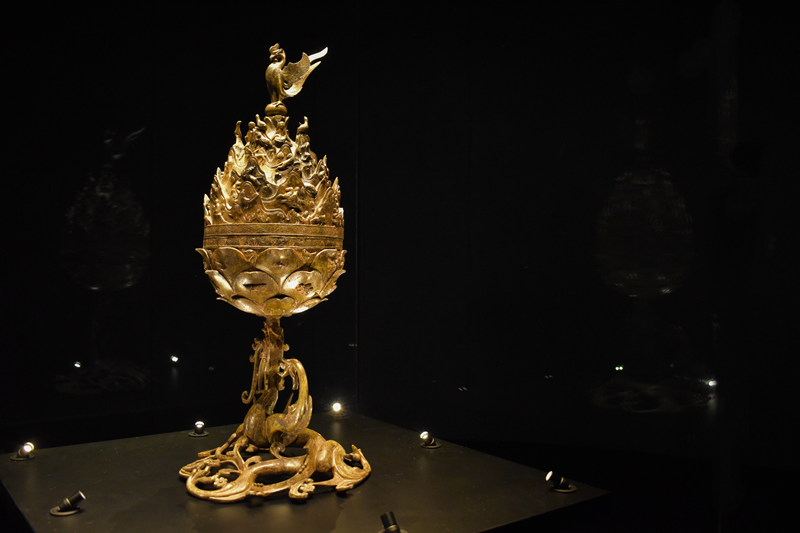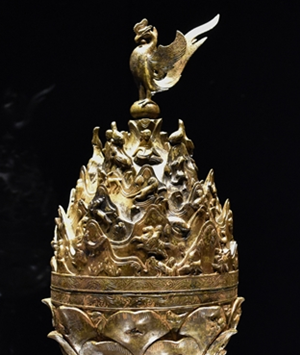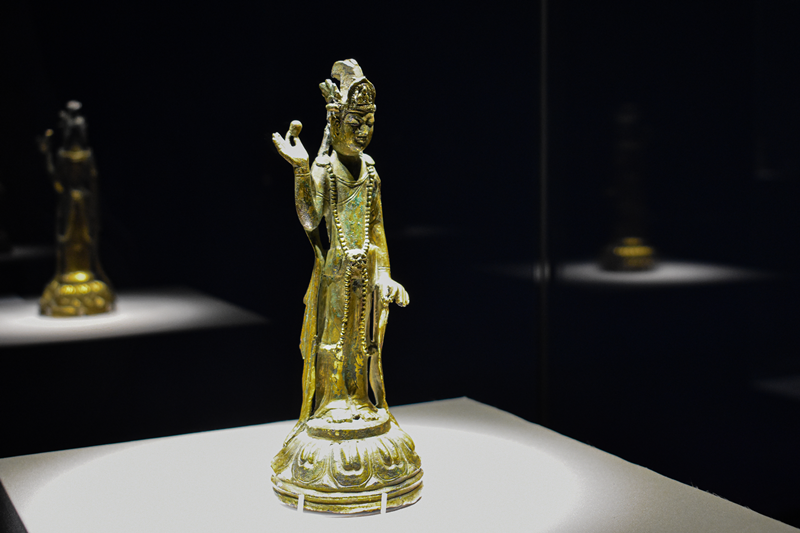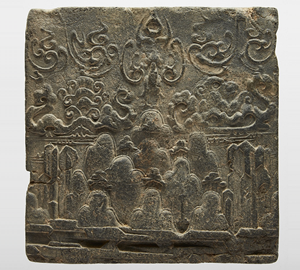
Designated a National Treasure in 1996, the Great Gilt-bronze Incense Burner of Baekje, which depicts Baksan Mountain, where Taoist immortals live, is far more sophisticated and developed than other artifacts made in the sixth century. (Choi Jin-woo)
By Hong Angie and Choi Jin-woo

Imaginary animals and figures appear on the Great Gilt-bronze Incense Burner of Baekje. The phoenix in the upper part represents well-being. (Choi Jin-woo)
At 61.8 cm tall, the relic realistically and vividly depicts the ideal world envisioned through the infinite imagination of the Baekje people. It was uniquely combined with the motif of the lotus signifying reincarnation and eternal life and that of a divine mountain symbolizing immortality and eternal life. In short, it is a symbol of everlasting life.
About 80 sculptures representing imaginary animals and figures are harmoniously arranged in the piece. The incense burner stand features a dragon vigorously flying to the sky with its head raised and a lotus flower in its mouth.
The body has three layers of rotating petals like a fully bloomed lotus flower. On the surface and between the petals are two Taoist immortals and 25 animals including the phoenix, fish, deer and crane. The 12 birds make them the most prominent creature on the piece.
The harmony of animals living on mountains and birds flying above carved on the lid of the relic creates the illusion of the viewer becoming a Taoist immortal. At the top, a phoenix with the apparent expression of contemplation of the world gently lands.
"Expressions of life-like creatures and illusionary mountain ridges are used but they're not awkward and feel unusually natural," the museum's associate curator Sin Min-cheol said. "This implies that this imitated the world imagined by ancient people."
On Dec. 12, 1993, the burner was discovered during an excavation of a temple site in the village of Neungsan-ri in Buyeo-gun in the western valley of the Buyeo Royal Tombs, which is known to house the grave of a Baekje king. It has never been taken out of the country for exhibition.
Shin added, "I hope many people visit our museum to see the incense burner in person."

Sin Min-cheol, an associte curator at Buyeo National Museum, said the hidden nickname of the Gilt-bronze Standing Avalokitesvara Bodhisattva from Gyuam-ri, Buyeo is "Miss Baekje" due to its resemblance with the Miss Korea beauty contest, in which contestants commonly pose with a smile and similar posture. (Choi Jin-woo)
At 21.1 cm tall, the statue has a natural and fluid expression. It slightly holds the edge of the robe with the thumb and index finger of the left hand and gently carries a small bead with the thumb and index finger of the right.
Shin said, "With a gentle facial expression, natural posture, gracefully flowing robe hem and elegant depiction of fingers holding a bead and the hem, these expressions show the mature beauty of Baekje sculpture."
Unlike other sculptures from the period, the bodhisattva work has body proportions changed from relief to round sculpture. Before this sculpture, the backside of such a sculpture was rather chunky but this one was very delicately decorated.
This is perhaps why the relic's arms and body are round and separate from each other, making the statue a work from a time of the development of casting technology and when creation of a 3D effect was possible.

Patterned Tiles from Oe-ri, Buyeo has a square form and is 29 cm long and 4 cm thick. (Buyeo National Museum)
Sporting a square form and 29 cm long and 4 cm thick, this work features a natural landscape like auspicious clouds, mountain with three soft peaks and rocks, and flowing water. Its poetic atmosphere and painting-like quality stand out, bringing to mind the Great Gilt-bronze Incense Burner of Baekje, which has a phoenix perched on top of a mountain peak.
Shin said, "The Patterned Tiles from Oe-ri, Buyeo uses a sense of stability stemming from a simple and balanced composition with the gentleness and softness unique to Baekje."
The museum houses most of these tiles. Eight patterned tiles designated National Treasures are displayed at Baekje Kingdom Hall of the National Museum of Korea in Seoul.
# More ways to enjoy Buyeo National Museum
- Visit Buyeo National Museum to experience the worldview of the Baekje people. At the lobby of the permanent exhibition hall, a daily laser show projects the utopia such people envisioned as reflected in the patterned tiles including the lotus incense and Great Gilt-bronze Incense Burner of Baekje . More information on content and schedules is available on the museum's official website: http://buyeo.museum.go.kr/content.do?key=2302160002 (Korean only).
- The museum also has a digital rest area for visitors, Feel the Baekje Kingdom, which replicates the traditional toenmaru, or a narrow wooden porch running along the outside of a room, and the low wooden bench pyeongsang. A big LED screen 12 m long and 2.4 m tall allows visitors to watch dynamic videos featuring the Baekje patterned tile exhibition including the Gilt-bronze Standing Avalokitesvara Bodhisattva from Gyuam-ri, Buyeo, Great Gilt-bronze Incense Burner of Baekje, Reliquary from Wangheungsa Temple Site, Buyeo and Oe-ri Site in Buyeo.
- Finding unique artifacts throughout the museum is fun. One of them is the portable Tiger-shaped Chamber Pot, a relic that recently attracted huge attention on social media.
![[Must-sees at Korean museums] ④ Buyeo Nat'l Museum](/upload/content/image/49249826d45a4c1e9e5f2dbd370962cb_20240418151235.png)
![[Must-sees at Korean museums] ③ Gwangju Nat'l Museum](/upload/content/image/a930dfb35b144d6abdfb4483adcc7bf4_20240314090859.jpg)
![[Must-sees at Korean museums] ② Gyeongju Nat'l Museum](/upload/content/image/9a4d39e2842348aca36c10d73fb90f0a_20240216114311.jpg)
![[Must-sees at Korean museums] ① National Museum of Korea (II)](/upload/content/image/1c4dec52513347a98b9c43c9fd62551e_20240118131624.jpg)
![[Must-sees at Korean museums] ① National Museum of Korea (I)](/upload/content/image/a39a36cb636e4c02aae1ab053f63fe57_20240112112911.jpg)
